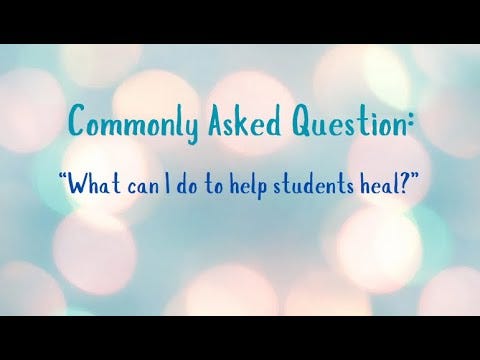This is the fourth in my Commonly Asked Questions series, if you have a question you’d like me to reframe and answer, leave it in the comments and I’ll give it a run!
Reframe: “How can we stop replicating educational trauma? How is it possible to teach and learn with joy in the face of enormous harm?”
Why reframe the question?
This question is fairly new in the ‘tired old questions’ game, but it is so unhelpful for teachers (and so many other non-health/therapeutic professionals) that I’ve made it a special project to clarify and reframe the question at every opportunity!.
I don’t know precisely when the idea of “healing” in the classroom started circulating. My guess is sometime in the last decade, after the Kaiser/CDC report on Adverse Childhood Experiences (ACEs) made it to the general public, so 2005 or later. The implications of the study didn’t make it into education right away, but when it did, it wasn’t long before the first wave of literature about trauma in the classroom hit the shelves.
Most of this literature has a great deal of overlap, including the following[1]:
It primarily discusses trauma in K-12, with little or no recognition of the impacts of trauma on adult learners,
The perspective on trauma is through the lens of healthcare, domestic violence and sexual assault prevention, and emergency response, largely because the ACE questions were developed from those perspectives, and
It do not address educational trauma as a learning-related harm, i.e. wounds that happen specifically during learning, and specifically impact learning, or the role of teachers in perpetuating that harm.
This body of work does take a close look at school problems including racism, gender discrimination, transphobia, misogyny, bullying, online peer pressure, and school shootings, along with many other harmful events and behaviors. People do good work connecting the need for physical and mental healthcare for students, and highlight how so many of our communities struggle to support students’ basic needs and provide foundational care for families.
None of this is wrong, and this body of work is directly relevant for school counselors, guidance counselors, and school social workers. But framing trauma “work” in only this way makes it a logical step for teachers to then take that healthcare/social work/counseling framing on themselves. Whether intentional or not, this positions teachers as ‘healers’ in a way none of us are equipped or resourced to do.
After all that backstory, my response to this question is: put healing out of your mind.
You don’t get to determine anyone’s healing but your own. It’s possible people will find a range of positive experience in your classroom, maybe they will find healing, but it’s really none of your business how they think about and label their experiences. I’d ask, instead, what can I do to help students be comfortable settling their bodies? How do I help strengthen their ability to learn? To rediscover joy in learning?
Perhaps more urgently, what are you doing to tend your own learning-related wounds? How are you interrupting patterns of educational violence in your classroom, in your teaching? What is your practice for identifying those patterns? What tools and skills are you using to interrupt yourself and make different teaching choices?
What does *your* healing feel and look like?
[1] I am also assuming the majority of this scholarship and practice prioritizes the individualistic, Western European approach to healthcare prevalent in the United States. I do not speak for work from outside the US.
Article series
Commonly Asked Questions (CAQ) Overview
Commonly Asked Questions #2: How do I get students to engage with uncomfortable topics?
Commonly Asked Questions #3: How do I motivate students to learn?



